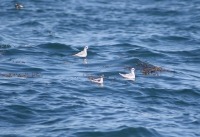
(Photo: Tracey Dean)
Red-Necked Phalarope
Phalaropus lobatus
This species is one of the world's smallest seabirds. It has a wingspan of 32 to 41 centimetres and weighs just 20 to 48 grams. During the breeding season, it is dark grey with a white wing bar, white chin and eye spots, white underside, and bright chestnut-red markings down the sides of its neck. Males are more muted in colour than females and have a less prominent eye spot.
Authority
Linnaeus, 1758
Classification Details
Phylum: Chordata (chordates); Subphylum: Vertebrata (vertebrates); Class: Aves (birds).
Habitat
Spends up to nine months of the year at sea. When breeding in the summer, it is found in the Arctic and sub-Arctic. Present across North America from Alaska to Newfoundland. It spends winters at sea, mostly in tropical waters including those off South America and in the Arabian Sea.
Diet
A visual predator that floats and pecks prey from just under the water surface. Phalaropes often spin while feeding - this is thought to create a miniature upwelling that brings prey to the surface so they can catch it. Prey is small invertebrates, particularly copepods and aquatic larvae of flies. In the Bay of Fundy, the main prey is the copepod Calanus finmarchicus.
Reproduction
Nests in vegetation, such as moss and sedge. Pairs make a scrape in the soil and line it with vegetation. The nest is often completely hidden by foliage. Females usually lay four eggs, leaving them to be cared for by the males. The males incubate these and brood the chicks. Females rarely return to the nest after laying their last egg but sometimes defend the male from the advances of unpaired females. Eggs are incubated for 17 to 29 days. Chicks can leave the nest within 24 hours. When they leave they can walk, run, swim, and find food on their own. The male cares for them for 10 to 14 more days: brooding them when they are cold, protecting them from predators, and leading them to good feeding areas. Chicks can fly when they are 16 to 17 days old. This species can live for more than 10 years.
Fun Facts
Up to 3 million red-neck phalaropes used to visit the Bay of Fundy on their fall migration, but now sightings are very rare. Scientists are not sure why the birds have disappeared from this area. It may be due to changes in ocean currents or prey distribution.
Red-necked phalaropes spin when feeding and during courtship. Individual birds always spin in the same direction - they may be left- or right-handed. They can spin up to 54 rotations per minute.
References
Chandler R, Everett M, Palmer P and Porter R (2015) The spinning behaviour of phalaropes. British Birds 108(2), 104–108. Duncan CD (1995). The migration of Red-necked Phalaropes: ecological mysteries and conservation concerns. Birding 28, 482-488. Mercier F and Gaskin DE (1985). Feeding ecology of migrating Red-necked Phalaropes (Phalaropus lobatus) in the Quoddy region, New Brunswick, Canada. Canadian Journal of Zoology 63, 1062-1067. Nisbet ICT and Veit RR (2015). An explanation for the population crash of Red-necked Phalaropes Phalaropus lobatus staging in the Bay of Fundy in the 198134s. Marine Ornithology 43(1), 119–121. Rubega MA, Schamel D and Tracy DM (2020). Red-necked Phalarope (Phalaropus lobatus), version 1.0. In Birds of the World (S. M. Billerman, Editor). Cornell Lab of Ornithology, Ithaca, NY, USA. https://doi.org/10.2173/bow.renpha.01

